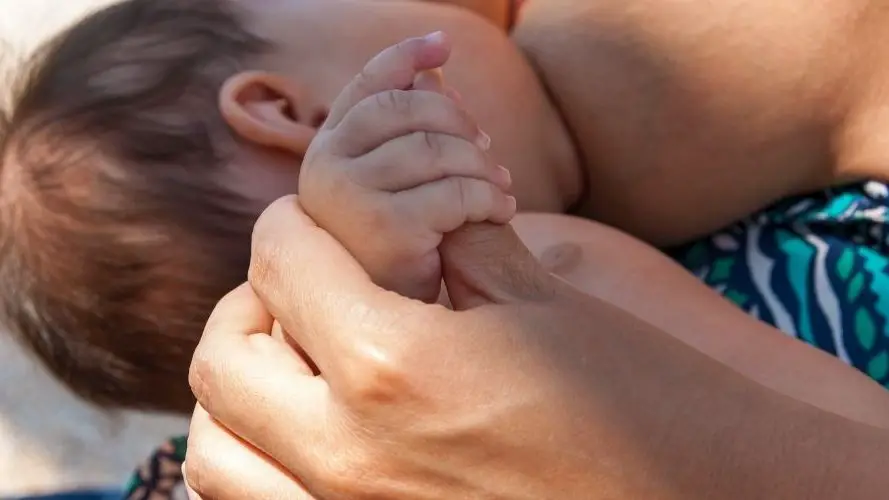If you’re experiencing unbearable nipple pain or a baby who just won’t latch properly, you’re likely at your wit’s end and maybe even ready to throw in the towel. Nipple shields can be an incredibly helpful tool on the road to a successful breastfeeding relationship.
The ultimate goal is to get your baby nursing on their own and to hopefully get some joy out of the experience. A nipple shield may help get you there, but only if used correctly to avoid further issues.
What is a nipple shield?
A nipple shield is a thin silicone cover that is placed over the nipple as needed while breastfeeding. The material is flexible with small holes in the tip for milk flow, and some have cutouts to provide extra skin-to-skin. It can protect cracked and bleeding nipples and help with latching issues.
Things to try before a nipple shield:
- First and foremost, if possible, try to avoid using a nipple shield in the first week of life. Babies often struggle to latch at first but do much better once your milk supply comes in. This rule does not apply to preemies.
- Tug your nipple, apply ice, or use a breast pump to extend the nipple as much as possible.
- Make your nipple more firm by compressing the breast like, well, a sandwich. Release your hold slowly after they begin feeding.
- Try different nursing positions.
- Seek out a breastfeeding professional to help with pain or latching challenges. While breastfeeding can be painful as your nipples adjust, if you are in prolonged or excruciating pain, there may be an underlying issue.
When should I use a nipple shield?
Nipple shields are generally meant for temporary use in conjunction with professional help from a health care provider or lactation consultant. Nipple shields can help with:
- Painful, cracked, or damaged nipples
- Premature babies struggling with coordination
- Flat or inverted nipples
- Oversupply and overactive letdown
- Babies who are struggling to latch onto the breast
- Lip ties and tongue ties
- Transitioning baby to a bottle or reintroducing the breast after bottle-feeding
What size should I use?
Just like breasts, nipple shields come in a variety of shapes and sizes. It’s very important to find the right size for you, which may require trial and error. A breastfeeding professional can help find the right size for you, or plan to order a few and try them out. Popular brands include Medela, Tulip, and Mamivac, all of which are shaped differently and come in a few sizes.
You want your nipple to fit inside the nipple shield and for the nipple shield to fit inside your baby’s mouth. The shield is too large if your baby gags on it and cannot latch, and it’s too small if your nipple touches the top part of the shield. You want the nipple shield to feel comfortable and leave room for your nipple to extend while feeding.
How do I use a nipple shield properly?
Alongside proper sizing, using the nipple shield correctly is a very crucial part of the process. When used incorrectly, nipple shields can cause pain and a decrease in milk supply.
- Soak the nipple shield in warm water before starting.
- Invert the shield and place your nipple into the raised, nipple-shaped part of the shield, stretching the shield onto your breast.
- Express some milk so that baby knows to latch.
- Hold the shield with your pointer finger and thumb while guiding the baby to your breast.
- Once they latch, make sure the entire nipple is in their mouth. If you have a cutout shield, the cutout should line up with the baby’s nose.
- You can try to remove the shield after a couple of minutes and have them latch onto your breast (this part does not apply or work for everybody).
- After each use, rinse in cold water and then wash the nipple shield in hot, soapy water.
How long will I need to use a nipple shield?
Nipple shields are not meant to be a long-term solution, but instead a helpful tool that promotes a healthy breastfeeding relationship. Once your nipples have healed and/or your baby is properly latching onto the breast, you can wean them off of the nipple shield. Keep in mind babies get used to them quickly and weaning can be difficult.
What are the pros of using a nipple shield?
- Your nipples have the chance to heal! One of the hardest parts of nursing is gritting your teeth in pain during feedings as your nipples adjust. This pain can be increased by lip and tongue ties.
- When used properly, a nipple shield can help babies learn to latch and provide a temporary solution while any underlying issues are dealt with.
- It makes breastfeeding easier for preemies who are not quite coordinated enough to latch or feed for long.
What are the cons of using a nipple shield?
- If used incorrectly, milk production can decrease. There is an extra barrier between the baby and your nipple, and the reduced nipple stimulation can decrease your supply. Some babies have a hard time getting milk through the shield.
- If baby is struggling with milk transfer, this can lead to clogged ducts and ultimately, mastitis.
- Babies quickly get used to the nipple shield, making it difficult to wean them off.
- It can make breastfeeding in public more awkward and difficult.
Should I avoid using a nipple shield?
You shouldn’t use a nipple shield unless you need one to continue breastfeeding due to latching challenges or damaged nipples. If you do find that using a nipple shield is necessary, it’s nothing to feel bad about.
While staunch breastfeeding advocates may discourage using nipple shields, silicone nipple shields are much thinner than older rubber ones, which cuts down on the negative effects. When used correctly with the ultimate goal of weaning, they can sustain the breastfeeding relationship instead of hurting it.1Nipple Shields Good or Bad?
breastfeeding.support
Nipple shields were controversial due to older studies reporting reduced milk transfer. However, more recent studies have determined that with the updated design of nipple shields and correct usage, nipple shields have led to many successful breastfeeding outcomes.2Chow, S., Chow, R., Popovic, M., Lam, H., Merrick, J., Ventegodt, S., … & Popovic, J. (2016). The use of nipple shields: a review. Frontiers in public health, 3, 236.
ncbi.nlm.nih.gov
Ultimately, without the aid of a nipple shield, many moms would instead wean their babies due to the overwhelming challenges faced.
How to prevent supply loss, clogged ducts, and mastitis
According to Kelly Mom, there are some steps you can take to prevent the disadvantages mentioned above.
- Monitor wet and dirty diapers to make sure your baby is getting enough milk. You want at least 6 soaked diapers every 24 hours. Babies that are 6 weeks or younger should have 3 poopy diapers a day, although that may slow down a bit after 6 weeks.
- Weigh your baby often, at least every two weeks, until steady weight gain is established.
- There are other ways to determine how well your baby is emptying the breast. You should be able to hear your baby swallowing milk, and your breasts should feel softer and emptier after feedings. If your breasts still feel full after nursing, you may want to pump to empty the breast and promote milk production.
How do I wean my baby from a nipple shield?
Weaning a baby off of just about anything can be stressful, but remain patient and try some of these tips and tricks.
- If you’re only using it to let your nipples heal, try to only use it sometimes or only on the nipple that hurts the most.
- Schedule all necessary appointments to address underlying issues such as a tongue tie or lip tie.
- Have skin-to-skin time to encourage the baby to latch on without the nipple shield, breastfeed frequently, and try different positions.
- Try to remove the nipple shield quickly once they have been feeding for a few minutes.
- Let them suck on your pinky beforehand, and encourage latching with a wide mouth.
- Pump for a few minutes before feeding so that the letdown has already been triggered and your nipples are elongated.
- Use the shield for the first breast but not for the second.
Editor’s Note:
Do not cut the tip of silicone nipple shields. Doing so will leave sharp edges.
It’s important to mention that some moms use nipple shields for their entire breastfeeding journey. If weaning is causing a lot of stress and resistance from your baby, back off and try again later. The weaning process can take anywhere from days to weeks. And if a nipple shield ends up being the best way to feed your baby, then it’s the best way to feed your baby.
Seek help from a professional
We can’t stress this enough: while Google searches and online communities can be very helpful, nothing beats the hands-on experience of a professional. A board-certified lactation consultant will be able to isolate any issues like tongue or lip ties and help you teach your baby to properly latch.


